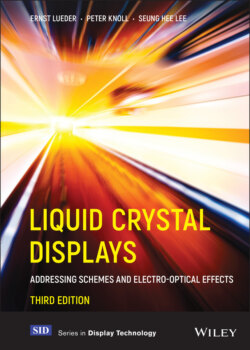Читать книгу Liquid Crystal Displays - Ernst Lueder - Страница 21
2.2.2 The addressing of LCDs by TFTs
ОглавлениеSo far we know that we have to control the grey shade individually in each pixel by applying the appropriate pixel voltage VLC, but by only using the external contact pads in Figure 2.9. The TFT-addressed LCD, usually called an Active Matrix LCD (AMLCD), solves this task as depicted in Figure 2.16. It shows two pixels of a row of pixels, with the row- and column- conductors and ground represented by the unstructured ITO electrode on the colour plate in Figure 2.15. The TFTs are n-channel Field Effect Transistors (FETs) fabricated with thin film technology. They operate as switches in the pixels. All TFTs in a row are rendered conductive by a positive gate impulse Vg. TFTs in other rows are blocked by grounding the rows. The video information is fed in through the columns and the conducting TFTs into all the pixels of a row simultaneously. More specifically, the video voltage Vd corresponding to a desired grey shade charges the LC-capacitor CLC and an additional thin-film storage capacitor Cs up to the voltage Vd. This constitutes an amplitude modulation. The operation addresses one line at a time, as opposed to one pixel at a time, of the e-beam in CRTs. During the charging time, the storage capacitor connected to the succeeding line n + 1 is grounded, and hence connected in parallel to CLC. As this is no more true during other phases of the operation, degradations of the addressing waveform are introduced, as discussed later.
The pixel switches have to charge N rows in the frame time Tf in which a picture is written. Hence, the row-address time is
(2.17)
The waveform of the pixel-voltage VLC is depicted in Figure 2.17. In the time Tr, the storage capacitors are charged with the time constant
(2.18)
where Ron is the on-resistance of the TFT. The inequality guarantees that at the end of Tr, the voltage VLC is only 1 percent below the desired voltage Vd in Figure 2.16. The TFTs need to be fast enough to make sure that even if their properties fluctuate, as indicated by dashed lines in Figure 2.17, they still charge the capacitors to the voltage Vd. After the time Tr, the transistor is blocked, but still has a finite off-resistance Roff. After Tf the row is addressed again and the new picture information is fed in. During this time, the discharge of the capacitors should be small to provide a luminance as constant as possible. This yields an almost flicker-free picture, again as opposed to the CRT, where in the absence of storage the luminance of the phosphor decays after having shortly been hit by the e-beam. The constraint for the time constant Toff of the discharge is
Figure 2.16 TFT addressing of the pixels in a row
Figure 2.17 Waveform of the voltage across a pixel during charging and discharge of the storage capacitor
(2.19)
which ensures a voltage drop of only 1 percent at Tf. From Equations (2.18) and (2.19), we obtain
(2.20)
For an NTSC display with N= 484, we require Roff/Ron ≥ 968 × 103. With the practically achievable value for the off-current Ioff= 1 pA, the value for the on-current Ion ≥ 1 μ A meets the constraint in inequality (2.20).
The voltage across the pixels has to be free of dc in order to avoid dissociation of the ingredients in the LC material. Therefore, the voltage VLC applied in the next frame time has the alternate sign as indicated in Figure 2.17. As we have observed in Section 2.2.1, the operation of the TN cell is independent of the sign of the electrical field vector. The alteration in sign from frame to frame is mandatory for a sufficient life of the LC cell. The transmitted luminance of an LC cell in Figure 2.13 exhibits a linear dependence on VLC in a range of about 3 V. For 256 grey shades, this results in steps of 11.7 mV/grey shade. Special care will be taken to ensure the accuracy of these steps, as the voltages are altered by parasitic capacitive couplings. Remedies against this damage will be the alternating signs of VLC from row to row, column to column, frame to frame, and combinations of these measures.
TFT-addressed LCDs offer an appealing picture quality, mainly due to the absence of flicker. TFTs are fabricated together with the storage capacitors, ITO electrodes and conductors in thin film technology on glass or plastics as substrates. Glass substrates used to be 1.2 mm thick, and are presently down to 0.7 mm, whereas plastic materials excel in a thickness of only 100 μ to 200 μ. As monocrystalline layers are unfeasible in thin film technology, the semiconductor in the TFTs is either amorphous or polycrystalline. Materials are a-Si, poly-Si and, more seldom, CdSe. Alternative pixel switches are MIMs or thin film diodes.
A more economical method of addressing does not require the above-mentioned pixel switches, and generates the voltages across the pixels by a superposition of voltages at the contact pads. This is called Passive Matrix (PM) addressing which, however, exhibits shortcomings.
A more detailed discussion of all addressing schemes starts with Chapter 10.
